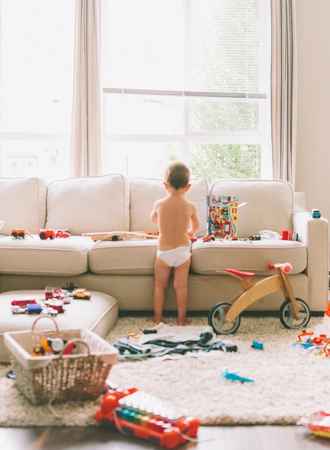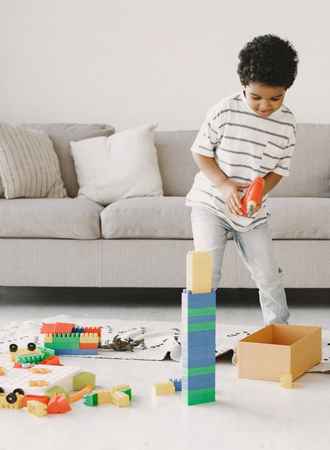Exploring the world of child development and pondering whether an overabundance of toys can have detrimental effects? You’re tapping into a pertinent question. In our consumer-driven society, where children often have access to a multitude of toys, concerns arise about potential overstimulation and its impact on development.
Interestingly, while toys are essential tools for play and learning, an excess can sometimes lead to unintended consequences.
Drawing from my expertise in child development and toys, I’ve structured a comprehensive guide that examines the potential impacts of having too many toys on a child’s development.
Let’s navigate this intricate balance, understanding the possible downsides of toy overload, and explore strategies to foster meaningful play and growth amidst a sea of playthings.
Key Takeaways on the Harmful Effects of Having Too Many Toys on Child Development
- Having too many playthings prevent kids from engaging in activities that help them develop their skills.
- Parents should avoid excessive consumerism, keep only open-ended materials, and limit their child’s toy collection to 20 items, if possible.
- To avoid having too many toys at home, parents should set a toy limit, support experiences over things, make a wish list for their child, donate old toys regularly, buy quality instead of quantity as much as possible, rotate toys every few weeks and choose toys with multiple uses.

What Happens if a Child Has Too Many Toys?
An excessive number of toys can potentially have negative effects on a child’s development. Here are some reasons why:
- Overstimulation: A vast array of toys can overwhelm a child, making it difficult for them to focus on any single activity, leading to reduced attention spans and difficulty concentrating.
- Reduced Creativity: With too many toys, children might not feel the need to use their imagination. Fewer toys can encourage kids to get creative and think of various ways to use a single toy.
- Lack of Appreciation: An abundance of toys can reduce the value a child places on any single toy, leading to a lack of appreciation and care for their belongings.
- Impaired Social Skills: With many toys, a child might opt for solitary play rather than sharing and playing with others. This can hinder the development of crucial social skills like sharing, cooperation, and negotiation.
- Decreased Problem-Solving Skills: A limited set of toys can encourage children to think of solutions when they face challenges or when a toy breaks. An endless supply might deter this problem-solving approach.
- Materialistic Values: Constantly receiving new toys can lead children to develop materialistic attitudes, prioritizing possessions over experiences or relationships.
- Reduced Mastery: Playing deeply with one toy helps children master it and gain a sense of achievement. Frequently switching between many toys can prevent this depth of interaction.
- Organization Challenges: Too many toys can lead to clutter, which might overwhelm children and make it difficult for them to keep their play areas organized.
- Parent-Child Interaction: An excessive number of toys might mean children play alone more often, missing out on quality interaction with parents or caregivers that is crucial for emotional and cognitive development.
- Environmental Impact: On a broader scale, continually buying toys contributes to consumerism and its associated environmental impacts, which can be an important lesson in sustainability for children.
It’s essential to strike a balance. While toys are beneficial for development, it’s the quality of play and engagement they offer, rather than the quantity of toys, that matters most.
Parents and caregivers might consider periodic toy rotations or decluttering to maintain a conducive play environment.
Too Many Toys Syndrome
“Too Many Toys Syndrome” (TMTS) is a colloquial term used to describe a situation where children have an excessive number of toys. This overabundance can lead to a range of issues and concerns for both children and parents.
| Aspect | Details |
|---|---|
| Overwhelm & Decision Fatigue | With too many options, children might become overwhelmed and find it hard to make a choice. This can lead to indecision and reduced playtime with any single toy. |
| Reduced Creativity & Imagination | An excess of toys, especially those that are prescriptive in their play patterns, can stifle creativity. Children might rely on the toy’s built-in functions rather than inventing their own play scenarios. |
| Shortened Attention Span | Constantly switching between toys can prevent children from engaging deeply with any one item, potentially affecting their ability to focus on tasks for extended periods. |
| Reduced Value & Care for Possessions | When children have too many toys, they might not value them as much. This could lead to a lack of care for their belongings and an attitude of disposability. |
| Decreased Social Skills | Over-reliance on individual toys can limit opportunities for shared play with peers, which is crucial for developing social skills like sharing, negotiation, and cooperation. |
| Materialism & Entitlement | Constantly receiving new toys can foster a sense of entitlement and an overemphasis on material possessions as a source of happiness. |
| Storage & Clutter | For parents, managing the sheer volume of toys can become a challenge, leading to cluttered living spaces and the added stress of organization and storage. |
| Economic Implications | Continuously buying toys can strain a family’s budget. It also contributes to consumerism and the environmental toll of producing, packaging, and eventually disposing of toys. |
| Reduced Interaction with Nature | An abundance of indoor toys might reduce the incentive for children to play outside, depriving them of the benefits of outdoor play and interaction with nature. |
Stifles creativity and imagination
Having too many toys can actually have a negative effect on the creativity and imagination of children. When a child has an excessive number of toys, they may become overwhelmed with choice paralysis and not know what to do with them all.
This can lead to a lack of imagination as the child becomes reliant on the toys to provide entertainment.
Having too many toys can limit a child’s ability to explore and invent games. When a child has fewer toys, they are forced to use their imagination to come up with ways to play with what they have. This can lead to a greater sense of creativity and resourcefulness as they learn to make the most of what they have.
Overstimulation
Overstimulation in young children can occur when they are exposed to too many toys. This can cause irritability, restlessness and anxiety. Having too many toys can lead to a lack of focus. Children may rely on the toys for entertainment rather than creating their own activities.
Kids may not appreciate the value of their toys and quickly become bored with them, leading to a desire for even more. To prevent overstimulation and promote healthy play habits, it is important to limit the number of toys and provide open-ended materials such as blocks or art supplies.
While toys are generally seen as beneficial tools for a child’s development, there are concerns that having too many toys can lead to potential drawbacks. The abundance of choices and stimuli might interfere with some aspects of a child’s developmental journey. Here’s an informative table that outlines how an excessive number of toys might affect a child’s development:
| Concern | Explanation |
|---|---|
| Overstimulation | An abundance of toys can overwhelm a child, leading to sensory overload. This might make it harder for them to focus on any single activity. |
| Reduced Creativity | With too many specific toys, children might rely less on their imagination to invent games or stories, potentially stifling creativity. |
| Decreased Value of Possessions | Having a plethora of toys may prevent children from valuing their possessions, as they might not learn to care for and cherish each item. |
| Shortened Attention Span | Continually jumping from one toy to another might inhibit the development of sustained attention and patience. |
| Less Social Interaction | An excess of toys could lead to more solitary play and less incentive for shared activities, potentially impacting social skill development. |
| Overreliance on External Entertainment | A child might become dependent on toys for entertainment, reducing their ability to find joy in simple, non-materialistic activities. |
| Reduced Problem-Solving Skills | With many toys, children might not explore each toy’s potential fully, missing out on opportunities to problem-solve or think critically. |
| Clutter & Disorganization | A surplus of toys can lead to cluttered spaces, which might induce feelings of stress or anxiety. Learning to organize and tidy up can also become more challenging. |
| Materialism | Growing up with an excessive number of toys might foster materialistic values, where a child equates happiness or self-worth with possessions. |
| Reduced Appreciation for Nature & Outdoors | A focus on indoor toys might detract from time spent outdoors, exploring nature, and participating in physical activities. |
It’s essential to strike a balance. While toys undoubtedly offer developmental benefits, moderation is key. Periodically rotating toys, ensuring they align with a child’s developmental stage, and emphasizing non-toy related activities can help mitigate potential negative impacts.
Encouraging children to donate or share toys they no longer use can also teach valuable lessons about generosity and value.

Excess toys can lead to decreased social interaction in kids by reducing their need to engage in social play with others. When kids have an abundance of toys, they may become more focused on individual play and less interested in sharing and collaborating with others.
This can result in a decrease in opportunities for social interaction, which are critical for developing social skills such as communication, empathy, and cooperation.
Excessive toy consumption can create a sense of entitlement and materialism in children, which can further undermine their willingness to share and engage with others.
Limits physical activity
Kids with an many toys don’t play outdoors and may not get enough physical exercise because they may become too engrossed in playing with their toys and may not feel the need or desire to engage in physical activity. If their play area is cluttered with toys, there may not be enough space to move around and play actively.
If they spend excessive amounts of time indoors playing with their toys, they may not have the opportunity to go outside and engage in physical activities like running, jumping, and playing sports, which can lead to a lack of exercise.

Prevents development of problem-solving skills
Having many toys may actually hinder a child’s problem-solving skills. When kids have too many toys, they are less likely to engage in imaginative play and explore creative solutions to problems. Instead, they may rely on pre-determined solutions or lose interest in toys quickly.
Having an abundance of toys can lead to a lack of focus and difficulty with decision-making. kids who have fewer toys are more likely to engage in creative play, use their imaginations to solve problems, and develop critical thinking skills, either at home or in the kindergarten classroom.
Therefore, it is important for parents to support open-ended play and limit toys their kids have access to, ensure there are plenty of construction and building toys (see our guide to the best construction and building toys)
Why Do Some Parents Buy Many Toys for Their Kids?
There are several reasons why some parents may choose to buy many toys for little boys and girls.
Parents may see toys as a way to promote their child’s learning. Age-appropriate toys can help children develop their cognitive, motor, and social skills through play.
Some parents may want to provide their babies and toddlers with a variety of options for play, which can help keep them engaged and stimulated. kids may have different interests and preferences, and having a variety of kids toys can cater to these individual differences – for example musical toys, dolls etc.
Parents may buy many toys as presents or gifts as a way to show their love and affection towards their children. Giving a gift during holidays, including toys, can be a way for parents to express their care and appreciation for their children.
However, it is important to note that excessive materialism and consumerism can have negative impacts on children’s development and well-being. Research suggests that excessive toy consumption can lead to increased stress, decreased creativity, and reduced social skills – we’re not saying there beloved toys are not good toys, but too much of a good thing…
Therefore, it is essential for parents to strike a balance between providing their children with opportunities for play and avoiding excessive consumerism. In fact, having lesser toys have an added benefit on the overall development of a kid, especially for younger children.
How Can Parents Avoid Having Too Many Toys for Their Kids?
As a parent, it can be tempting to buy lots of toys for your kids. However, too many toys can create clutter and overwhelm your children. Here are some helpful tips to avoid ending up with too many toys at home:
- Set a toy limit. Don’t let your child play with all of their toys. This will help you avoid buying too many toys and keep your child’s toy collection under control. Boredom set in at first, but keep in mind that having to manage toys takes away the time you should be spending with family members. Don’t let online toy sales growing dominance sway your limits.
- Encourage experiences over things. Instead of buying toys, try giving toddlers experiences like a trip to the zoo or a movie night. This will help them create memories and have fun without adding more toys to their collection.
- Make a wish list. Ask your child to one toy or game they want (preferably from specialist toy stores which have the best educational toys). This will help you avoid buying toys that they might not be interested in and prevent clutter.
- Donate old toys. If you have so many toys at home, encourage your child to donate their old toys to charity or a friend who might need them. This will help keep their toy collection under control and teach them about the importance of giving.
- Buy quality over quantity. Invest in high-quality toys that will last longer instead of buying cheap toys that break easily. This will help you avoid having to constantly replace broken toys with new toy sets.
- Rotate toys. Keep only a few toys out at a time and use a toy rotation every few weeks. This will keep your child’s toy collection fresh and exciting without adding too many toys at once.
- Buy toys with multiple uses. Look for large toys and playsets that have multiple uses, like blocks or puzzles. This will help you avoid buying too many toys and encourage your child’s creativity.

What Is the 20 Toy Rule?
The 20 toy rule is a popular minimalist approach and parenting strategy that aims to simplify your child’s toy collection and reduce clutter in your home. The rule suggests that you limit your child’s toys to 20, with the goal of encouraging creativity, imagination, and independent playtime.
The 20 toy rule encourages parents to choose toys that are versatile, open-ended, and encourage exploration and problem-solving. This can include toys like building blocks, stuffed toys, art materials, outdoor toys, dress-up clothes, and puzzles.
By limiting the toys your child has, you can help them to focus on the toys they do have and encourage them to use their imagination to create their own activities.
It can help to reduce the constant influx of new toys and the clutter that can come with it, which can be overwhelming for both children and parents – so just one or two toys out at once for quality playtime.
How Many Toys Should Kids Have?
The number of toys kids should have is a question that many parents often ask themselves. While there is no one-size-fits-all answer to this question, there are a few factors that you can consider to help you decide how many toys are appropriate for your child.





